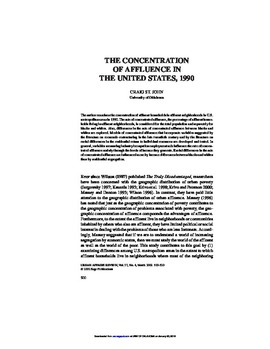| dc.contributor.author | Craig St. John | |
| dc.date.accessioned | 2016-01-14T19:53:35Z | |
| dc.date.accessioned | 2016-03-30T15:30:56Z | |
| dc.date.available | 2016-01-14T19:53:35Z | |
| dc.date.available | 2016-03-30T15:30:56Z | |
| dc.date.issued | 2002-03-01 | |
| dc.identifier.citation | St. John, C. (2002). The Concentration of Affluence in the United States, 1990. Urban Affairs Review, 37(4), 500-520. doi: 10.1177/10780870222185441 | en_US |
| dc.identifier.uri | https://hdl.handle.net/11244/25340 | |
| dc.description.abstract | The author examines the concentration of affluent households in affluent neighborhoods in U.S. metropolitan areas in 1990. The rate of concentrated affluence, the percentage of affluent households living in affluent neighborhoods, is considered for the total population and separately for blacks and whites. Also, differences in the rate of concentrated affluence between blacks and whites are explored. Models of concentrated affluence that incorporate variables suggested by the literature on economic restructuring in the late twentieth century and by the literature on racial differences in the residential return to individual resources are developed and tested. In general, variables measuring industry/occupation employment mix influence the rate of concentrated affluence mainly through the levels of income they generate. Racial differences in the rate of concentrated affluence are influenced more by income differences between blacks and whites than by residential segregation. | en_US |
| dc.language.iso | en_US | en_US |
| dc.publisher | Urban Affairs Review | |
| dc.title | The Concentration of Affluence in the United States, 1990 | en_US |
| dc.type | Research Article | en_US |
| dc.description.peerreview | Yes | en_US |
| dc.description.peerreviewnotes | https://us.sagepub.com/en-us/nam/manuscript-submission-guidelines | en_US |
| dc.identifier.doi | 10.1177/10780870222185441 | en_US |
| dc.rights.requestable | false | en_US |
